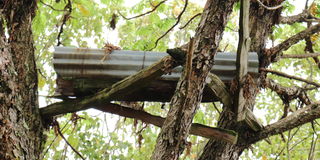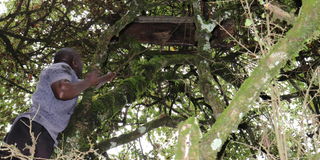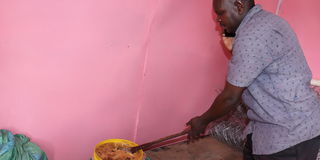How the Ogiek in Molo use honey as food, medicine and dowry

A traditional beehive is mounted inside Mau Forest by the Ogiek community on May 8, 2024.
Honey.
Who doesn’t love a little sprinkle of honey on their bread, tea, and Dawa? But where does your honey come from, do you know?
And I’m not talking about honey from the supermarket.
Within the Ogiek community, honey serves multiple purposes—it is cherished as a symbol of celebration, valued for its medicinal properties, and enjoyed as a source of food.

Stephen Lele inspects a beehive inside Mau forest on May 8, 2024.
For women, honey holds significance as part of traditional dowry practices, which symbolize wealth and prosperity.
On the other hand, men utilize the honey in traditional brewing of beer and circumcision ceremonies.
Additionally, honey is valued for its medicinal properties, with men, women, and children using it to treat various ailments and to boost immunity.
It was also previously used as a form of barter trade with the Maasai community, a tradition that has eroded over time.
Stephen Lele, a resident of Marioshoni ward in Molo sub-county and a seasoned beekeeper, recounts his experience paying his wife’s dowry using a pail of honey and compares how modern beer has been destructive to the youth as opposed to the traditional one made from honey.

Stephen Lele displays some of the honey collected from beehives inside Mau Forest on May 8, 2024.
He although questions how there is honey all through the year yet honey is harvested twice annually.
Lele notes the cyclical nature of beekeeping, with peak and off-peak seasons, and attributes this irregularity to the adverse impacts of climate change.
Claire Rono, who has been a beekeeper in Marioshoni ward since 2011, notes how they have categorized the honey from the sweetest, somehow sweet, bitter, and honey from stingless bees.
The bitter honey she says is always recommended for medicinal purposes.
Despite efforts by the government to introduce modern beehives to the community, they still largely rely on their traditional log hives noting the tree used is bee-friendly as opposed to the modern ones.
Clare who has both modern and traditional hives notes how out of the four modern hives she has only two that are functional and still she gets very little honey compared to her traditional hives.

Some of the modern beehives covered with aluminium.
“Many of the modern hives are not made up to standard, as they use the cypress tree which has a pungent smell repelling the bees. Sometimes, they use wood that has not dried well which later on forms mould. Additionally, the aluminium cover used ontop of the hive becomes excessively hot during warm seasons and too noisy during rainfall, both of which bees find unfavourable,” says Clare.
Fascinatingly in the Ogiek community honey harvesting is left for men, while women like Clare have to hire someone to help them with the process.
Stephen and Clare are determined to uphold their traditional beekeeping practices and are deeply concerned about the widespread felling of indigenous trees and the use of inorganic pesticides in modern agriculture and argue their detrimental impact on the reduction of bee colonies and honey production.
To counter this, they’ve been mobilized into a cooperative of over 350 beekeepers and set up their traditional hives inside the Mau Forest to distance the bees from the flowers of agricultural produce, to preserve the natural taste of honey.
Over and above this, they are actively planting indigenous trees that bees use as forage crops to increase their production of honey and protect what’s left of the forest.
